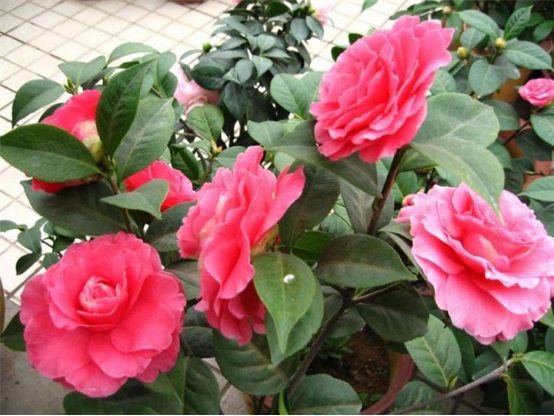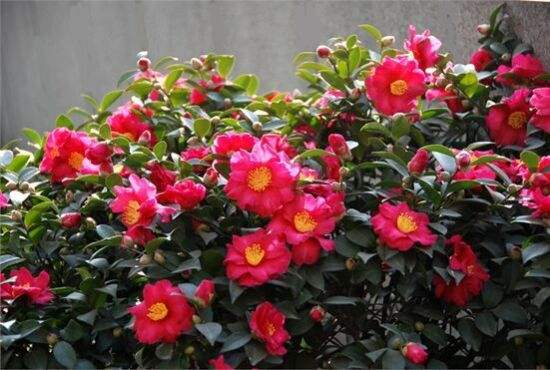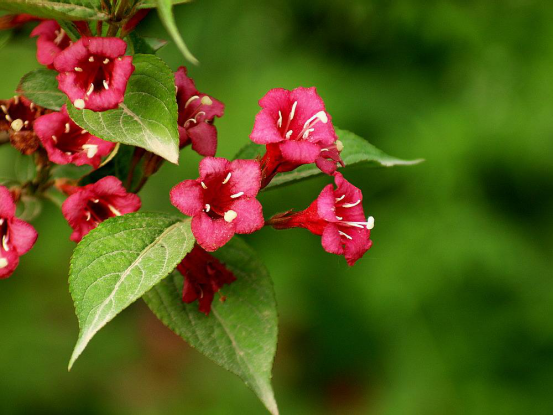I. maintenance methods of tea plum bonsai
1. sunshine
Chamei likes yin and dampness, and it is most suitable for half yin and half yang. Summer light may burn its leaves and buds, causing the leaf rolls to fall off. But it also needs proper lighting to bloom luxuriantly and brightly.
2. soil
It is suitable for fertile, loose, well-drained acidic sandy soil, alkaline soil and clay are not suitable for planting tea plum. It is suitable for growth in humus-rich, moist slightly acidic soil, pH 5.5~6 is appropriate.
3. temperature
It is cold-resistant, but potted plants are generally not lower than-2℃, and the optimum temperature is 18~25℃. Strong resistance, fewer pests. Available sowing, cuttage, grafting methods, such as propagation.

4. Pest control
Tea plum diseases and insect pests are less, the main diseases are gray spot disease, soot disease, anthracnose, etc., to prevent and treat early, once the disease occurs, the same amount of Bordeaux mixture 300 times spray kill. If there are scale insects, red spiders and other harm, available artificial brush in addition to red spiders occur, available bubble tobacco water mixed with pepper water spray kill, the effect is also very significant. Do not use pesticides to prevent environmental pollution.
5. pruning
Timely pruning can not only make tea plum bonsai tree beautiful, but also reduce excess nutrient consumption, so that nutrition concentration, flowers and leaves luxuriant. Generally, each branch leaves a bud, and the rest should be cut off without hesitation. Branches that have bloomed and branches that affect the beauty of potted plants should also be cut off completely.
Second, the precautions for the maintenance of tea plum bonsai
1. Avoid leaving too many buds
2. Avoid high room temperature
3. Avoid poor air
4. Avoid changing positions frequently
Tea plum bonsai production and maintenance methods Tea plum bonsai boutique picture appreciation
Although tea plum is a shrub or small tree, but its beautiful shape attracted a lot of flower friends, choose to use tea plum to do bonsai, but the production and maintenance of bonsai also requires skills, otherwise it will destroy the growth of plants. Today, wed114 wedding network Xiaobian brings you tea plum bonsai production and maintenance methods, sharing tea plum bonsai boutique picture appreciation.
Tea plum bonsai production and maintenance methods:
1, material selection
Low plants, slow growth, small leaves, soft branches of tea plum is more suitable for processing modeling, such as expansion of low winter tea plum.
Ordinary tea plum more upright varieties can also try to do towering bonsai, but it is best not to use tall plants, rapid growth, large flowers and leaves varieties.
2. Source of materials
It is best to use 2-3 years old cuttings or seedlings, because the branches of seedlings are easier to process and shape, and can be cultivated into various trees according to the modeling requirements during the cultivation process.
Old branches such as wild golden camellia and camellia oleifera can also be excavated through trunk cutting grafting method or new branches sprouted from residual old trees, and old tea plum pile pots can be made through continuous modeling.
Tea plum bonsai production and maintenance methods:
3. Modeling
Generally, the natural posture of the tea plum plant is mainly used or artistic treatment is performed, and it is processed into straight dry type, inclined dry type and double dry type, and it can also be cultivated into curved dry type, cliff type and semi-cliff type with metal wire or binding.
4. Late maintenance
Generally two to three years to change the pot once, in addition to choosing a good color, size, style of pot body and plant match, the pot body had better be smaller, do not choose a large one, about one-half of the crown.
Properly cut off residual roots and some old roots, help shallow root system better development, but also help plant dwarfing, planting plant stem base needs to be slightly higher, beyond the edge of the pot, exposed roots of plants to avoid wind blowing, exposure.
In the case of not affecting the growth and development, try to apply less fertilizer. In order to maintain the balance and nature of the tree posture, it is not advisable to cut off the top at will. In the growing season, it is possible to trim the branches lightly, remove the unwanted or too long growth buds with the topping method, and prune and reshape more intensively before germination.
In addition to excessive branches, if there are too long or excessive branches, you can cut off a longer section of the top tip, or you can use metal wire from below to twist to shorten.
Do not store it indoors for too long, which will affect the growth and development of tea plum.
Tea plum bonsai production method, as well as the production of maintenance methods tea plum, is not only with the characteristics of camellia, but also with the characteristics of plum blossoms. Its flowers are full, colorful, flowering time is long, there are many colors. Tea plum is ornamental flowers, it can be made into bonsai at home conservation. Today, I will take you to learn about the bonsai production of tea plum.
Bonsai making
1. material selection
Low plants, slow growth, small leaves, soft branches of tea plum is more suitable for processing modeling, such as expansion of low winter tea plum. Ordinary tea plum more upright varieties can also try to do towering bonsai, but it is best not to use tall plants, rapid growth, large flowers and leaves varieties.
2. material source
It is best to use 2-3 years old cuttings or seedlings, because the branches of seedlings are easier to process and shape, and can be cultivated into various trees according to the modeling requirements during the cultivation process. Old branches such as wild golden camellia and camellia oleifera can also be excavated through trunk cutting grafting method or new branches sprouted from residual old trees, and old tea plum pile pots can be made through continuous modeling.
3. modeling
Generally, the natural posture of the tea plum plant is mainly used or artistic treatment is performed, and it is processed into straight dry type, inclined dry type and double dry type, and it can also be cultivated into curved dry type, cliff type and semi-cliff type with metal wire or binding.
4. later maintenance
(1)Generally two to three years to change the pot once, in addition to choosing a good color, size, style of pot body and plant match, the pot body had better be smaller, do not choose a large one, about one-half of the crown.
(2)Properly cut off residual roots and some old roots, help shallow root system better development, but also help plant dwarfing, planting plant stem base needs to be slightly higher, beyond the edge of the pot, exposed roots of plants to avoid wind blowing, sun exposure.
(3)In the case of not affecting the growth and development, try to apply less fertilizer. In order to maintain the balance and nature of the tree posture, it is not advisable to cut off the top at will. In the growing season, it is possible to trim the branches lightly, remove the unwanted or too long growth buds with the topping method, and prune and reshape more intensively before germination.
(4)In addition to excessive branches, if there are too long or excessive branches, you can cut off a longer section of the top tip, or you can use metal wire from below to twist to shorten. Do not store it indoors for too long, which will affect the growth and development of tea plum.
The above is my arrangement of tea plum bonsai production methods and maintenance knowledge, I hope to be helpful to the majority of flower friends, please continue to pay attention to the fleshy flower beds, to learn more about flower maintenance knowledge.
- Prev

What are the advantages of making bonsai with tea plum:
Tea plum tree is relatively small, its branches are also relatively low, it is easy to trim shape, tea plum bonsai is also born. The tea plum tree shape is very beautiful, the leaves are very elegant, and the flowers are very beautiful, and the flowering period can be from November of that year to March of the following year, so making bonsai is of high ornamental value.
- Next

Four Propagation methods of Brocade
one。 Cutting planting variant types of brocade flowers, we usually use cuttings. In summer, cut 1-2-year-old ungerminated branches, cut into branches of about 13cm length as cuttings, and then dip cuttings with a-naphthylacetic acid 2000mg/kg solution
Related
- Fuxing push coffee new agricultural production and marketing class: lack of small-scale processing plants
- Jujube rice field leisure farm deep ploughing Yilan for five years to create a space for organic food and play
- Nongyu Farm-A trial of organic papaya for brave women with advanced technology
- Four points for attention in the prevention and control of diseases and insect pests of edible fungi
- How to add nutrient solution to Edible Fungi
- Is there any good way to control edible fungus mites?
- Open Inoculation Technology of Edible Fungi
- Is there any clever way to use fertilizer for edible fungus in winter?
- What agents are used to kill the pathogens of edible fungi in the mushroom shed?
- Rapid drying of Edible Fungi

